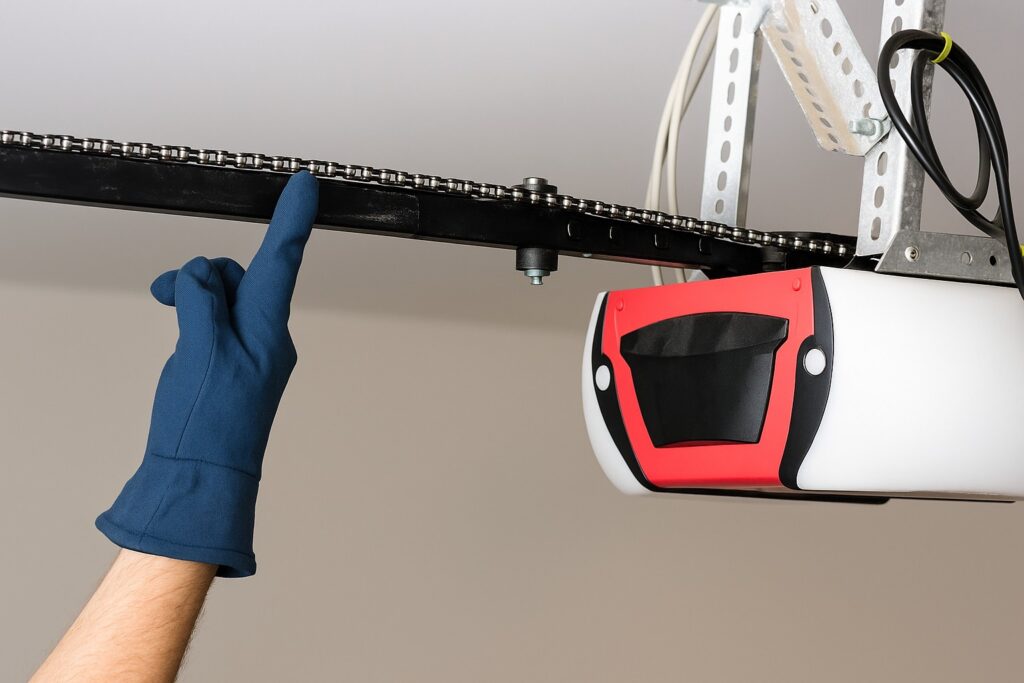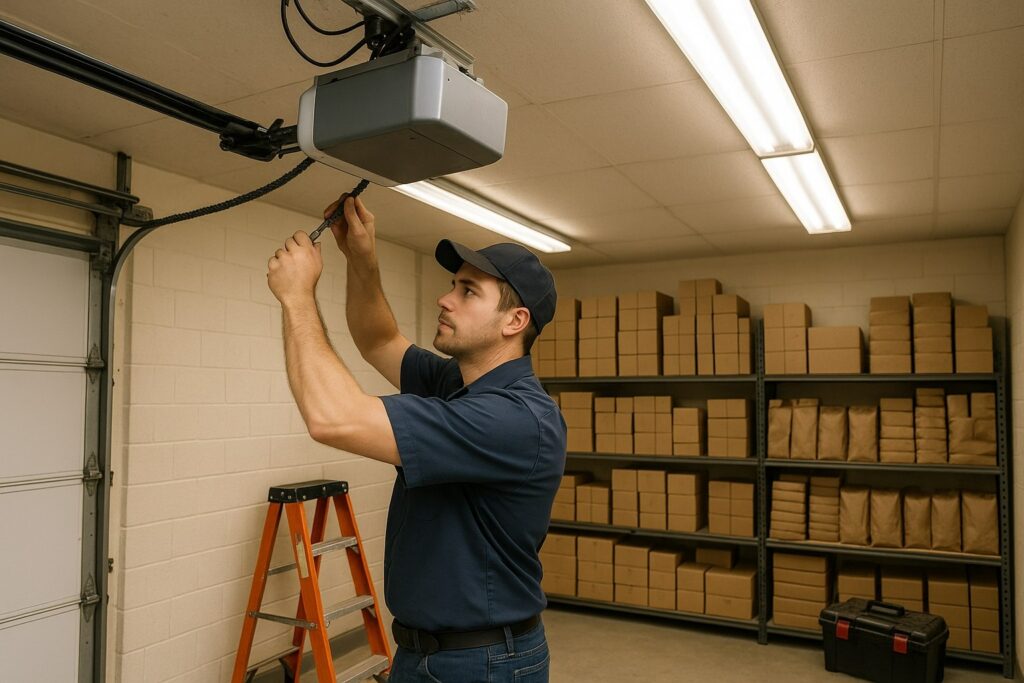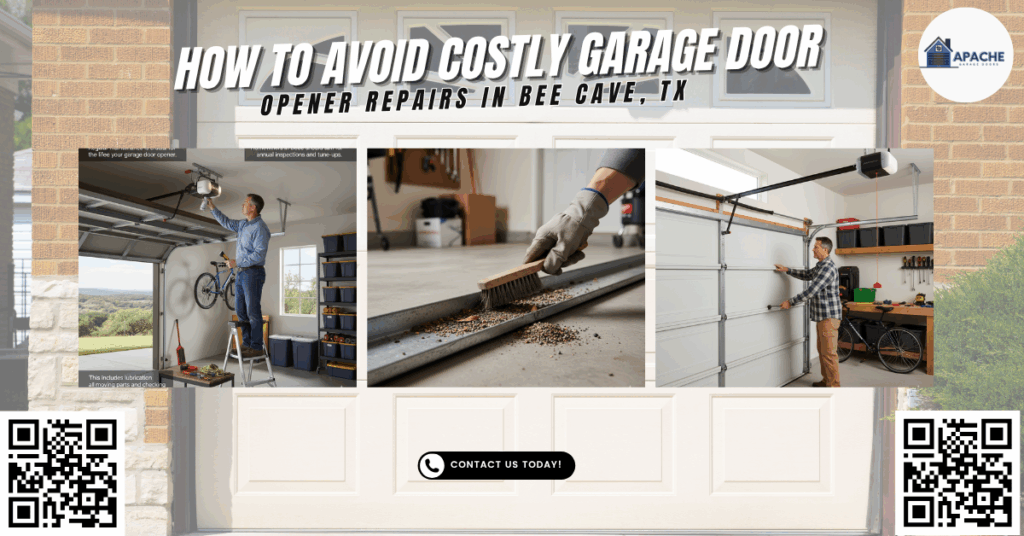If your door hesitates, squeals, or stops halfway, your first thought is often “uh-oh, this sounds expensive.” You are not alone. We take calls every week from Bee Cave neighbors whose systems finally gave up after months of small warning signs. A timely garage door opener repair would have been simple and affordable if those signs had been caught early. The good news is that most big bills are avoidable with the right habits, clear safety steps, and a little local know-how.
Here is a quick story. A family in Bee Cave noticed their chain-drive unit rattling each morning. The door still opened, so it felt safe to ignore it. By midsummer, the motor housing cracked, the sprocket bent, and the opener failed on a stormy night when the battery had not been replaced. A preventive visit in spring would have tightened the chain, added lubricant, checked force and travel limits, and swapped an eight-dollar battery. Instead, they needed a new unit. The lesson is simple. Small attention prevents large replacements.
In Central Texas, heat, dust, and power fluctuations are part of life. Those factors dry out lubricants, confuse safety sensors, and stress electronics. This expanded guide from Apache Garage Doors explains how your system works, what to check each season, how to tune settings, when to call a pro, and how to choose models that match your home and door weight. Use it like a workshop manual you can actually understand. We keep the language friendly for an eighth-grade reader, but the steps are the same ones our trained technicians use on real jobs.
Opener Anatomy: What Each Part Does and Why It Matters
A garage door opener looks simple on the ceiling, yet it coordinates many parts.
- Motorhead runs the show. It turns electrical power into motion.
- Drive system moves the trolley that pulls the door: chain, belt, screw, or direct-drive.
- Trolley and arm connect the opener to the door.
- Rail keeps the trolley moving straight for smooth operation.
- Logic board is the computer. It stores your remotes, keypad codes, and safety logic.
- Safety sensors watch the doorway with an infrared beam.
- Limit switches and force settings tell the door when to stop and how hard it can push.
- Emergency release lets you lift the door by hand when needed.
- Battery backup keeps everything working during an outage.
When even one piece struggles, the motor must work harder. That extra strain shows up as noise, heat, vibration, and higher repair costs over time.
The Three Golden Rules of Low-Cost Ownership
- Keep the door easy to lift. The opener is not a forklift. Balanced springs and smooth rollers protect the motor.
- Keep the electronics clean and stable. Dust the sensors, protect the logic board from surges, and replace small batteries on time.
- Keep friction low. Lubricate moving metal, tighten hardware, and reduce vibration at the mounting points.
If you follow these three rules, your odds of an emergency breakdown drop dramatically.
Types of Openers: Choose the Right Drive for Your Door and Lifestyle
Picking the best drive type prevents headaches years later. Here is a plain-spoken guide.
Chain-Drive Openers
- Strengths: Durable, strong for heavy doors, and budget-friendly.
- Watch-outs: More noise and vibration. Needs regular lubrication and chain tension checks.
- Best for: Detached garages or families who do not mind sound.

Belt-Drive Openers
- Strengths: Quiet, smooth, great for attached garages near bedrooms.
- Watch-outs: The belt still needs tension checks, especially after hot summers.
- Best for: Most Bee Cave homes that value low noise.
Screw-Drive Openers
- Strengths: Fewer moving parts, fast, good in wide temperature ranges when maintained.
- Watch-outs: Needs the right lubricant and seasonal attention.
- Best for: Doors that open and close many times a day.
Direct-Drive Openers
- Strengths: The motor moves along the rail, so there is very little vibration.
- Watch-outs: Higher upfront price, yet low long-term maintenance.
- Best for: Homeowners who want years of smooth, quiet operation.
Local tip: For the Austin and Bee Cave area, heat and dust make belt-drive and direct-drive units very popular for attached garages. Chain-drive remains a good choice for detached outbuildings and heavier wood doors.
Seasonal Maintenance Calendar for Bee Cave, TX
Use this as a fridge checklist. It keeps your door, opener, and wallet happy.
Every Month
- Test auto-reverse. Place a 2×4 on the floor under the door. Close the door. It should touch the board and reverse right away.
- Watch the door cycle. Listen for new noises. A squeal, rattle, or clunk is a clue.
- Sensor check. Make sure the photo eyes face each other. Gently clean the lenses.
Every Three Months
- Lubricate properly.
- Rollers with bearings: one drop on the bearing seam.
- Hinges: a small drop on the pivot point.
- Springs: a light spray along the coils.
- Top of the chain or screw: a thin, even coat with a silicone or lithium product.
Do not lubricate nylon roller tires or the track surfaces. Too much product attracts dust and creates grime.
- Tighten hardware. Snug the lag screws at the header bracket and ceiling brackets.
- Test balance. Pull the emergency release. Lift the garage door halfway. It should stay put. If it drops or flies up, call for a spring adjustment.
Every Six Months
- Replace remote batteries. Low power creates intermittent failures that look like major repairs.
- Reprogram remotes if needed. This clears old codes and uses modern rolling code technology for extra security.
- Inspect weather stripping. A good bottom seal supports energy efficiency, keeps out dust, and reduces strain because the door closes cleanly.
Once a Year
- Professional tune-up. A trained technician can test force, travel limits, spring torque, cable condition, end bearing plates, center bearing, drums, and roller wear, then inspect the logic board for heat stress.
The Sound Map: What That Noise Usually Means
- Rattling or clanking: Loose chain, loose hardware, or worn trolley.
- Screeching: Dry hinges or rollers.
- Grinding: Worn gear and sprocket assembly inside the motor head.
- Banging at open or close: Limits out of range, door hitting the stop too hard.
- Humming but not moving: Motor capacitor or jammed door due to a bent track or broken spring.
Catching these sounds early turns a large repair into a fast single visit.
Step-by-Step: Aligning Safety Sensors the Right Way
- Cut the power at the opener, unplug, or use the wall button to stop motion.
- Measure height. Both sensors should sit at the same height, usually six inches from the floor.
- Set the brackets so the lenses face each other straight across.
- Clean the lenses with a soft cloth.
- Restore power and test. The indicator lights on most models glow steadily when aligned.
- Confirm operation by waving a broom through the beam as the door closes. The door should reverse immediately.
Aligned sensors protect people, pets, and your car bumper, and they prevent “false repairs” where the door refuses to close.
Force and Travel Limits: How to Stop a Door from Slamming or Stalling
Your opener needs to know two things. How far to move and how much push is safe.
- Up and Down Travel: Sets where the door stops at the top and at the floor.
- Up and Down Force: Sets how hard the motor can pull or push before stopping.
Small plastic dials or buttons on the motor head control these settings. If the door slams the floor, back off the down travel slightly. If the door stops short, add a touch more. If the door struggles or does not reverse on contact, reduce the force and book a professional inspection. Always retest the auto-reverse after any change.
Power Quality, Surges, and Why Battery Backup is Worth It
Texas storms and summer heat cause brief outages and spikes. Those spikes can damage the logic board. Install a high-quality surge protector on the opener circuit. If your unit supports battery backup, keep a fresh battery installed. A charged battery lets you open the garage during outages, keeps the safety sensors alive, and prevents panic during late-night storms.
Remote Controls, Keypads, and Interference
If the remote works from the driveway but not from the street, you likely have a low battery. If it fails randomly, consider interference.
- Common interference sources: LED bulbs not rated for openers, Wi-Fi routers too close to the motor head, old fluorescent ballasts, and nearby devices on the same frequency.
- Fixes: Use opener-rated LED bulbs, move the router a few feet away, and reprogram remotes. Most modern LiftMaster and similar brands use rolling code technology that resists scanning and keeps your access code safe.
The Door Itself: Springs, Rollers, and Why Balance Protects the Motor
The opener is the coach, but the springs and rollers are the athletes. When the springs are set correctly, you can lift the door with two fingers. If not, the motor strains, the gear wears, and the electrical parts overheat.
- Torsion springs above the door shaft should be quiet and evenly spaced. Gaps or rust are red flags.
- Extension springs along the tracks should have safety cables through the center to prevent whipping if a spring breaks.
- Rollers come in steel or nylon. Nylon rollers with good bearings reduce noise and friction and support energy savings because the door seals more consistently.
Spring work is not a do-it-yourself job. The tension is high and can be dangerous. Call a trained technician for adjustments or replacement.
Weather, Insulation, and Energy Efficiency
Bee Cave summers heat the garage like an oven. A hot garage stresses electronics and dries out lubricants.
- Weather stripping around the sides and top, plus a healthy bottom seal, keeps dust and hot drafts out.
- Insulated garage doors with a higher R-value moderate temperature swings.
- Attic and garage ventilation reduces heat build-up around the motor head and logic board.
You will enjoy smoother operation, and your opener will live a longer life.
Smart Features, Security, and Everyday Convenience
New garage door openers include helpful features:
- Smartphone control to check the door status and get alerts if it stays open.
- Rolling code security that changes the code with each press.
- Timer-to-close to automatically close after a set time, helpful for busy mornings.
- Motion-activated lighting for safe entry.
- Camera options in some models for extra security.
If you support elderly parents or have teens who come home from practice, these features add real convenience and safety.
When to Repair and When to Replace
Choose repair when:
- The unit is under ten years old.
- The door is balanced, and the issue is a sensor, remote, limit, or small gear.
- The motor is strong but needs minor parts.
Choose replacement when:
- The unit is older than its typical life and has repeated failures.
- The logic board or motor windings are damaged.
- You want quiet operation, battery backup, and modern security features.
- You are upgrading to new garage doors that are heavier or wider.
Our team will give you clear options so you can decide with confidence.

Practical Cost Savers That Work
- Keep spares on hand. One keypad battery, two remote batteries, and a small tube of lithium or silicone lubricant.
- Use opener-rated bulbs. Cheap bulbs can cause interference and false failures.
- Train the family. Show everyone the emergency release, the wall button lock, and how to check if the path is clear.
- Avoid pulling the door by the handle when the opener is engaged. This bends the arm and strains the trolley.
- Do not hang storage from the opener rail. That rail is not a shelf.
Small habits, real savings.
Safety Essentials You Should Never Skip
- Test sensors monthly. That quick broom-wave test prevents accidents.
- Keep kids away from remotes as toys.
- Never loosen spring hardware. That is a professional task only.
- Know the manual release. Practice once with the door down and the path clear.
- Look and listen. Changes in sound or speed are your early warning.
Real-World Case Files from the Bee Cave Area
- The silent fix. A home near Lakeway called about random reversals. We found the sun hitting one photo eye at a sharp angle each afternoon. The cure was a small visor to shade the sensor and a micro-adjustment to alignment. Repair time is twenty minutes, cost is minimal, zero parts.
- The phantom opener. A family in Spicewood had their door open at night. The cause was a sticky wall button shorting the low-voltage circuit. Replacing the button and inspecting the wire solved it.
- The summertime stall. A garage in Dripping Springs reported a stall on hot afternoons. The motor capacitor was weak and failed under heat. A quick capacitor swap, plus a surge protector and new LED bulbs, gave the system another solid stretch of years.
These examples show that a careful inspection often reveals a small cause behind a big headache.
Model and Brand Notes
We service most brands and models, including LiftMaster, Chamberlain, Genie, and direct-drive units. We see the full mix of chain-drive openers, belt-drive openers, screw-drive openers, and direct-drive openers across Travis County. If you bought online from a national franchise or a local showroom, we can tune and maintain it. If your home once had work done by a company you found when searching terms like Welborn garage, veteran garage door, precision garage door, or even an online garage door retailer, we are happy to help with maintenance, repairs, or a clean installation that matches your door weight and usage.
Frequently Asked Questions (FAQs)
1. How often should I replace my garage door opener altogether?
Most garage door openers last between 10 to 15 years, depending on usage and maintenance. If you notice frequent breakdowns, louder noise, or outdated safety features, it may be time to upgrade to a newer, more energy-efficient model.
2. Can a power outage damage my garage door opener?
Yes, sudden power outages or surges can harm the opener’s circuit board. Installing a surge protector and keeping a battery backup helps protect your system and ensures operation during electrical interruptions.
3. Are smart garage door openers worth the investment?
Smart openers offer convenience and enhanced security through smartphone control, activity alerts, and remote access. They can also integrate with home automation systems, making them a practical long-term upgrade for homeowners in Bee Cave, TX.
4. How can I make my existing garage door opener quieter without replacing it?
Switching to nylon rollers, lubricating metal parts, and tightening loose hardware can significantly reduce noise. Adding vibration-isolating mounting brackets or a rubber pad under the opener unit can also help create smoother, quieter operation.
A Simple Pre-Service Checklist
Before you call, take five quiet minutes to observe one full open and close.
- Stand inside with the path clear.
- Note the speed, noise, and any hesitation.
- Watch the top seal touch the header at open.
- Watch the bottom seal compress gently at close.
- Check the sensor lights and the wall button light.
- Confirm the light on the motor turns on and off as expected.
Share those notes with our technician. It saves time and reduces repair costs because we can go straight to the likely cause.
How Can Apache Garage Doors Help You?
At Apache Garage Doors, we specialize in keeping your system safe, quiet, and reliable, with a focus on preventing big expenses through smart maintenance.
- Comprehensive inspections and tune-ups: We test balance, force, travel limits, springs, cables, rollers, bearings, sensors, and logic boards in a single visit.
- Expert repairs on all drive types: Chain, belt, screw, and direct-drive. We carry high-quality parts to finish most jobs in a single visit.
- Professional garage door installations: We match motor power, rail length, and safety features to your door size, weight, and usage.
- Preventive maintenance plans: Scheduled service that protects your warranty, reduces noise, and extends opener life.
- Same day service and clear communication: Friendly technicians, clean work, and free estimates before we begin.
📍 Address: Co Rd 226, Florence, TX 76527, United States
📞 Call Today: (254) 331-3535 for scheduling, free estimates, or emergency help.
Final Thoughts
A dependable garage door opener adds daily comfort and real security to your home. Most costly repairs do not arrive without warning. They start as a squeak, a wobble, a slow close, or a blinking sensor light. By following a simple monthly routine, replacing tiny parts like batteries on schedule, and booking a professional tune-up once a year, you protect your investment for many years.
Think of your system as a team. The springs balance the weight. The rollers lower the friction. The weather stripping seals out dust and heat. The sensors guard your family. The logic board coordinates all the players. Your role is to listen, look, and keep up with easy tasks. Our role is to handle the precision adjustments, safety-critical work, and expert diagnosis.
If you are ready for quieter mornings, safer evenings, and fewer surprises, contact Apache Garage Doors today. We will help you choose the right features, tune the settings, and build a maintenance plan that fits your home and schedule. Together, we can keep repairs small, performance high, and your door moving smoothly every day.

